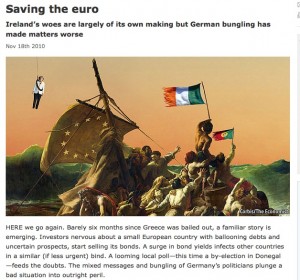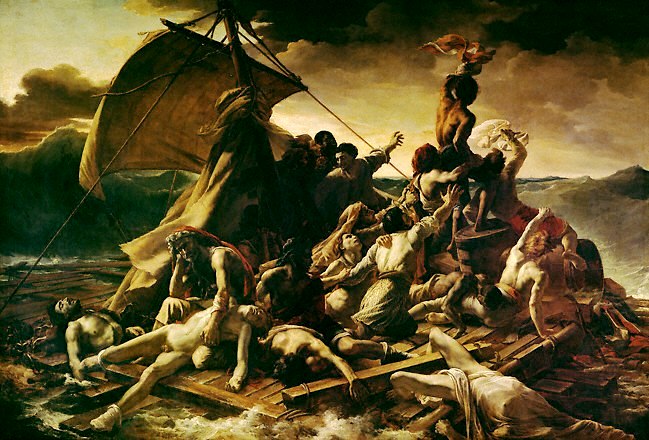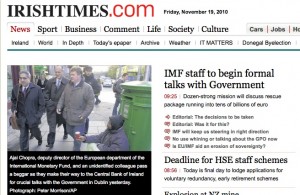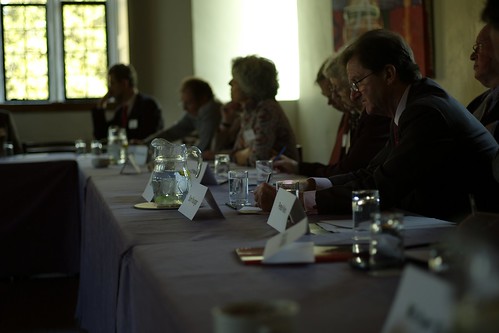The wreck of the Republic
The Economist has a wickedly funny front cover this week. It takes Gericault’s famous picture, The Raft of the Medusa, and Photoshops it to show the wretches on the raft holding Irish and other European flags, and adds, top-left, an RAF rescue helicopter winching in a particularly stolid-looking Angela Merkel to ‘help’.
The imagery becomes even more hilarious when you know the history of the original.
The painting depicts the aftermath of the wreck of the French naval frigate Méduse, which ran aground off the coast of today’s Mauritania on July 5, 1816. According to Wikipedia, at least 147 people
were set adrift on a hurriedly constructed raft; all but 15 died in the 13 days before their rescue, and those who survived endured starvation, dehydration, cannibalism and madness. The event became an international scandal, in part because its cause was widely attributed to the incompetence of the French captain acting under the authority of the recently restored French monarchy.
The references to cannibalism and incompetence are particularly relevant to Fianna Fail, hitherto known as “the political wing of the Irish construction industry”.
LATER: Lorcan Dempsey pointed me at John Banville’s essay in the New York Times:
It is the figures, mainly, that cow us into silence. It is estimated that the banking debt of this nation, which has a population of only 4.6 million, may be substantially more than 100 billion euros. That is 100,000 millions and rising. When we were at school it amused our science teachers to dazzle us with astronomical statistics — so many myriads of light years, so many zillions of stars — but the numbers that we are being forced to count on our too-few fingers now have nothing to do with the fanciful dimensions of outer space. They represent precisely the breadth and depth of the financial hole into which we have toppled headlong.
In the months after September 2008, when the Irish government, after a night-long crisis meeting, was forced to give a guarantee of some 400 billion euros — money we had no hope of ever having — to save the Irish banks from collapse, we used to say that it would fall to our children to pay for our financial folly. Now we know that it will be our children and our children’s children and our children’s children’s children, unto the nth generation, who will bear the burden of our debts, including the “substantial loan” from international lenders that officials now acknowledge is necessary.
There used to be a nice acronym that neatly expressed how the Irish people conceive of themselves: MOPE, that is, Most Oppressed People Ever. For a decade or so, when the Tiger was at its fiercest, we threw off the mantle of oppression, as once we had thrown off what used to be called “the yoke of British rule.” On Wednesday, the British chancellor of the Exchequer, George Osborne, announced in Brussels that his government stood ready to help Ireland in its hour of need. Oh, bitter day.
All the same, life goes on, somehow. We are learning a new resilience. Humbled as we are, we might even begin to learn social responsibility, a quality in which we have been singularly lacking up to now. Who knows, we may at last recognize the irreplaceable value of public and private honesty. But let us not light the firecrackers just yet.
Morning
The decisive… er, embarrassing moment
Today’s Irish Times has an extraordinary photograph on its front page. It shows Ajai Chopra, the Deputy Director of the European Department of the IMF, passing a beggar on his way to the Irish Central Bank in Dublin. Great photograph by Peter Morrison of AP.
Thought experiments
Fellow symposium members, in reflective mood.
The ‘Ghost Estates’ myth
One of the most depressing aspects of big news stories is the herd-like way in which mainstream media construct a narrative and then select only the facts that fit that narrative. Part of the narrative of the Irish economic collapse is the factoid that there are 300,000 unfinished or unoccupied houses in the Irish Republic at present. So it’s refreshing to find this careful piece by Bill Nowlan which tries to take a more dispassionate view.
LAST April I wrote a paper on so-called “ghost estates” for the Irish Planning Institute’s annual conference. At that time, the topic was red hot but all the debate was based on media reports, academic number-crunching and hard luck stories – there were no hard facts.
In my paper I called for a detailed survey and analysis so that Government, financiers, academics and planners could separate facts from fiction and develop action policies.
That survey has now been completed by the Department of the Environment It has been a big job with Government inspectors visiting each of just 2,900 estates – but the output is good. It turns out that there was, and is a lot of misinformation about so-called ghost estates. The survey shows that whilst problems do exist with empty and incomplete developments, they are far fewer than media and other reports would have us believe.
The survey identified more than 2,800 housing developments where construction had started but had not been completed.
This translates into just 180,000 housing units for which planning permission exists. Construction had begun on more than 120,000 of these dwellings with 77,000 dwellings completed and occupied.
A further 23,000 homes are completed and vacant. Another 10,000 are part-completed, requiring final fit-out and connection to services. The remaining 10,000 dwellings are at earlier stages of construction, from preliminary site clearance up to wall plate level. The balance are the units which have planning permission but have not been started.
These figures have already been reported – so why am I revisiting the issue? Well I suppose facts make far less interesting reading than much of the speculation to which we were treated for the past 12 months with sensational TV programs and acres of newsprint about disastrous estates with more than 100,000 vacant houses – the implication being that they were so-called ghost estates.
In fact there are only 23,000 new houses built and unoccupied in what I will call new estate developments. This is just 2 per cent of the overall national stock of homes in the country. The number of part-built houses at 10,000 is insignificant, equating to about three months work in a normal property and construction environment.
The survey shows that much of the vacancy in such estates is in western counties and numbers for the greater Dublin area are so low it could be argued that there is a potential shortage of new houses in the area when the economy recovers.
The detail of the survey does not support the idea that there are large numbers of tumbleweed estates. A few do exist but these are mainly outside the areas of normal demand…
Was it for this?
That’s the headline over an extraordinary Editorial in today’s Irish Times as the paper contemplates the wreckage and humiliation that a corrupt and incompetent Fianna Fail administration has brought on my homeland.
IT MAY seem strange to some that The Irish Times would ask whether this is what the men of 1916 died for: a bailout from the German chancellor with a few shillings of sympathy from the British chancellor on the side. There is the shame of it all. Having obtained our political independence from Britain to be the masters of our own affairs, we have now surrendered our sovereignty to the European Commission, the European Central Bank, and the International Monetary Fund. Their representatives ride into Merrion Street today.
Fianna Fáil has sometimes served Ireland very well, sometimes very badly. Even in its worst times, however, it retained some respect for its underlying commitment that the Irish should control their own destinies. It lists among its primary aims the commitment “to maintain the status of Ireland as a sovereign State”. Its founder, Eamon de Valera, in his inaugural address to his new party in 1926, spoke of “the inalienability of national sovereignty” as being fundamental to its beliefs. The Republican Party’s ideals are in tatters now.
…
Irish history makes the loss of that sense of choice all the more shameful. The desire to be a sovereign people runs like a seam through all the struggles of the last 200 years. “Self-determination” is a phrase that echoes from the United Irishmen to the Belfast Agreement. It continues to have a genuine resonance for most Irish people today.
The true ignominy of our current situation is not that our sovereignty has been taken away from us, it is that we ourselves have squandered it. Let us not seek to assuage our sense of shame in the comforting illusion that powerful nations in Europe are conspiring to become our masters. We are, after all, no great prize for any would-be overlord now. No rational European would willingly take on the task of cleaning up the mess we have made. It is the incompetence of the governments we ourselves elected that has so deeply compromised our capacity to make our own decisions.
They did so, let us recall, from a period when Irish sovereignty had never been stronger. Our national debt was negligible. The mass emigration that had mocked our claims to be a people in control of our own destiny was reversed. A genuine act of national self-determination had occurred in 1998 when both parts of the island voted to accept the Belfast Agreement. The sense of failure and inferiority had been banished, we thought, for good.
To drag this State down from those heights and make it again subject to the decisions of others is an achievement that will not soon be forgiven. It must mark, surely, the ignominious end of a failed administration.
Well, yes. But the problem is that there is no knowing what kind of electoral result will follow from this catastrophe. With a bit of luck, Fianna Fail’s run as a serious political party has finally ended, just as — in the end — Italy’s Christian Democrats imploded. But what then? Most of the Irish political establishment is implicated in the disaster that was the Celtic Tiger. One option is that public fury will erupt at the next election in a Tea Party-type explosion of incoherent activism, and Ireland will wind up with an administration rather like that of the Netherlands, in which a party of enraged, contradictory, xenophobic weirdos hold the balance of power.
And then there is the sinister news that Gerry Adams, sensing an opportunity, has decided to resign his seat in the Northern Ireland Assembly to stand for the Dublin parliament.
LATER: In a discussion on RTE Radio this evening, the former Taoiseach, Garret Fitzgerald, made an ironic point — reminding listeners that the revolutionaries whose insurrection in 1916 eventually led to the founding of the Republic were also hoping for German aid!
Why prediction is futile
At Tuesday afternoon’s Web 2.0 Summit in San Francisco, Vinod Khosla, founder of Khosla Ventures, took the stage to discuss the difference between innovation and punditry. He started off by mentioning a 1986 study that forecasted that by the year 2000, there would be just under one million cell phones. They were off by 10,000%. There were 109 milllion cell phones in the year 2000. AT&T spent $1 million and then ended up scrapping its whole cell phone business based on this forecast. Why? Because the 1980 ‘mobile phone’ was the size of a cinder block.
He then moved on to a Berkeley study that followed 80,000 forecasts over the course of 20 years and found that “experts have about the same accuracy of dart-throwing monkeys,” said Khosla. “You don’t do unreasonable things by being reasonable.”
Twitter, for example, did not exist five years ago, Khosla added. Which pundit could have predicted that a 140 character tweet would ever take off the way it did, or that a series of 140-character tweets could outline the whole culture and character of a city, like San Francisco when the Giants won the World Series?
Things like Twitter are created by innovators, not pundits.
“In every generation, you’ve seen radical shifts…Almost certainly, the next big thing won’t come from Google, Facebook, or Twitter.” To drive his home point, Khosla pointed out the fact that in the 1980s, no one thought there would be a PC in every home, and in the early 90s, no one could have predicted that email would’ve taken off. Even more shocking, the iPhone didn’t exist before 2007. “Now, it is conventional wisdom,” said Khosla.
[Source]
Show-offs
So, what’s up?
Dave Winer drew my attention to this. (It’s now noon in the UK, so there are three hours to go.) Dave, needless to say, has a theory about it. But I’m completely in the dark. As usual.
2.12pm:Just opened an email from my mate Andrew who says that it’s obviously the news that the Beatles’ music is finally being sold by the iTunes store. Now why didn’t I think of that?








